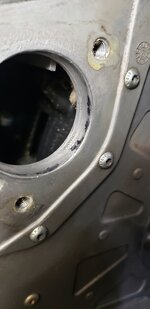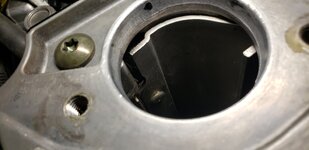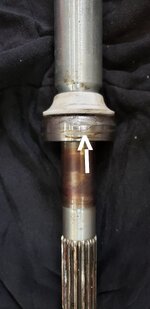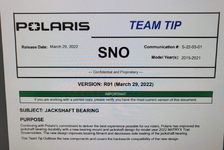Install the app
How to install the app on iOS
Follow along with the video below to see how to install our site as a web app on your home screen.
Note: This feature may not be available in some browsers.
Polaris jackshaft bearing notice
- Thread starter NHRoadking
- Start date
You are using an out of date browser. It may not display this or other websites correctly.
You should upgrade or use an alternative browser.
You should upgrade or use an alternative browser.
Yep it appears to apply to Axys trail sleds.Trail sleds only?
Sent from my SM-G998U using Tapatalk
And First year matryx.
I think the trail sled brake discs are inboard like the old days.Concerning the jackshaft, What is different between the trail sled and the chain case RMK?
Sent from my SM-G998U using Tapatalk
Vs the mtn chaincase having disc outboard.
Trail sled brake discs are outboard of the chaincase, just like the chaincase mtn sleds. Have been for years, since the Pro Ride trail sleds showed up. Trail sleds have a jackshaft bearing deflector inboard of the PTO side bearing, there since Axys. Mtn sleds do not. Same PTO side jackshaft bearing is spec'ed for all jackshafts, trail, mtn with case, and QD. Jackshaft chaincase bearings the same for both trail and mtn chaincases. Jackshafts have always been different between trail and mtn sleds, regardless of chain vs. QD. New jackshaft for the 22 trail sleds vs. the 21s, same bearings and flanges. Perhaps it could be as simple as trail sleds typically get alot more miles out of a chassis than a mtn sled, and they are minimizing changes and cost. Good Q for Hay Days at the poo booth.
Last edited:
I'm always amazed at the on-going issues with jackshaft bearings due to side loading...on all brands. Why don't they use dual tapered roller bearings made for both radial and axial stresses? I get that those bearings cost a few bucks more, but I've seen so much warrantee stuff around drive bearings, including jackshafts.
The side loading can be eliminated if they would give up on using a pressed-on bearing and go back to a set screw or a skews collet type locking bearing. These bearings are not designed to be side loaded, and when they are it creates excess heat that will spend the grease load long before it was designed for leading to failure. Bearing damage will also occur with heavy side loading even with ample grease supply. The concept of repacking will only prolong the time to failure if the bearing is being side loaded. (I still would like to see a grease Zirk there again though) The jackshafts do not currently have room to install these other types of bearings so a revision to the jackshaft would be needed. It is unreasonable and silly to even try to make a tunnel, chain case, bulkhead, and Pto bearing support assembly that is bolted, glued and rivited together and hold a plus or minus tolerance of .015" needed to avoid excessive side loading. Using a lockable bearing would allow you to install your jackshaft, install your top sprocket and lock it down which pulls it into the position it needs to be and then lock the driven side bearing to the shaft into the place that your assembled chassis needs it to be. The bottom driveshaft bearing has been known to have issues also that could also be related to side loaded bearings,I'm always amazed at the on-going issues with jackshaft bearings due to side loading...on all brands. Why don't they use dual tapered roller bearings made for both radial and axial stresses? I get that those bearings cost a few bucks more, but I've seen so much warrantee stuff around drive bearings, including jackshafts.
The other solution that can be used to address current units would be to develop a procedure to measure your assembled chassis to determine the correct placement of the pressed-on bearing and then press your bearing on to the exact location that your assembled chassis requires. Polaris used to make a tool that allowed you to lock your jackshaft to the chain case and then shim your chain case to align with your as-built chassis. They had a procedure in the repair manual to do this. I believe mfg has come a long way since then and trust that the chain case actually lines up better with the other side of the chassis, so this type of alignment procedure is no longer needed but my point is that they addressed that issue with a procedure then and they should also do it now for this issue. I suggest making a tool that is basically a solid dummy driven side bearing that is a slip fit over the jack shaft. You would install this on the jackshaft, install the jack shaft and lock down the top chain case sprocket to pull the jack shaft into position, then a measurement can be taken from the end of your jackshaft to the dummy bearing tool. This measurement will then be used to press on your new bearing to the correct position that your assembled chassis requires. This procedure should be included in the master repair manual.
The side loading can be eliminated if they would give up on using a pressed-on bearing and go back to a set screw or a skews collet type locking bearing. These bearings are not designed to be side loaded, and when they are it creates excess heat that will spend the grease load long before it was designed for leading to failure. Bearing damage will also occur with heavy side loading even with ample grease supply. The concept of repacking will only prolong the time to failure if the bearing is being side loaded. (I still would like to see a grease Zirk there again though) The jackshafts do not currently have room to install these other types of bearings so a revision to the jackshaft would be needed. It is unreasonable and silly to even try to make a tunnel, chain case, bulkhead, and Pto bearing support assembly that is bolted, glued and rivited together and hold a plus or minus tolerance of .015" needed to avoid excessive side loading. Using a lockable bearing would allow you to install your jackshaft, install your top sprocket and lock it down which pulls it into the position it needs to be and then lock the driven side bearing to the shaft into the place that your assembled chassis needs it to be. The bottom driveshaft bearing has been known to have issues also that could also be related to side loaded bearings,
The other solution that can be used to address current units would be to develop a procedure to measure your assembled chassis to determine the correct placement of the pressed-on bearing and then press your bearing on to the exact location that your assembled chassis requires. Polaris used to make a tool that allowed you to lock your jackshaft to the chain case and then shim your chain case to align with your as-built chassis. They had a procedure in the repair manual to do this. I believe mfg has come a long way since then and trust that the chain case actually lines up better with the other side of the chassis, so this type of alignment procedure is no longer needed but my point is that they addressed that issue with a procedure then and they should also do it now for this issue. I suggest making a tool that is basically a solid dummy driven side bearing that is a slip fit over the jack shaft. You would install this on the jackshaft, install the jack shaft and lock down the top chain case sprocket to pull the jack shaft into position, then a measurement can be taken from the end of your jackshaft to the dummy bearing tool. This measurement will then be used to press on your new bearing to the correct position that your assembled chassis requires. This procedure should be included in the master repair manual.
Agree with all that for alignment reasons. But the nature of these shafts and bearing assemblies will induce side loads due to chassis stresses/shifting during operation, track loading and thermal expansion/contraction. Because no matter how well the alignment, you still get the side loads on the bearings. Certainly using bearings that can't withstand a side load is bad design premise from the start.
O
Good thread.
The bearing isn't the problem. Its the cast mount that's not seated to outer bearing spherical race properly. Use some machine bluing ink or a black felt marker(not as messy)
I tested this on my 2021 850.
Pulled jackshaft out. Cleaned everything. Put black felt marker all over outer spherical race.Tightened chaincase side first,then mounting bracket. You can see where bearing was seated in a few spots. It side loaded & cracked the outer race. I caught this in time.
The (machined bearing mount) for 2022 is supposed to seat bearing properly. I just machined mine.



The bearing isn't the problem. Its the cast mount that's not seated to outer bearing spherical race properly. Use some machine bluing ink or a black felt marker(not as messy)
I tested this on my 2021 850.
Pulled jackshaft out. Cleaned everything. Put black felt marker all over outer spherical race.Tightened chaincase side first,then mounting bracket. You can see where bearing was seated in a few spots. It side loaded & cracked the outer race. I caught this in time.
The (machined bearing mount) for 2022 is supposed to seat bearing properly. I just machined mine.



T
Did just changing the bracket that hold the bering in place and reusing your 2021 parts solve your bering issue ?Thank you TerryGood thread.
The bearing isn't the problem. Its the cast mount that's not seated to outer bearing spherical race properly. Use some machine bluing ink or a black felt marker(not as messy)
I tested this on my 2021 850.
Pulled jackshaft out. Cleaned everything. Put black felt marker all over outer spherical race.Tightened chaincase side first,then mounting bracket. You can see where bearing was seated in a few spots. It side loaded & cracked the outer race. I caught this in time.
The (machined bearing mount) for 2022 is supposed to seat bearing properly. I just machined mine.
Similar threads
- Replies
- 71
- Views
- 5K
T
- Replies
- 6
- Views
- 911
T
B
- Replies
- 0
- Views
- 2K
B



